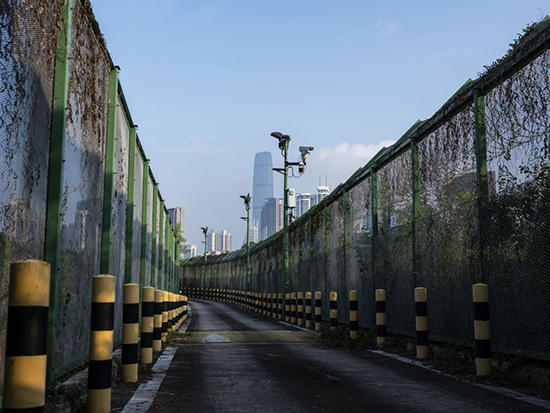深圳與香港:咫尺之隔,兩個世界

|
去年年底開通的一條高鐵線路,將香港和深圳中央商務區之間的旅行時間縮短至區區15分鐘。但如果你乘坐這趟列車,你可能會覺得自己是在兩個不同的世界之間穿梭。 在香港,就在距離紅磡火車站只有幾分鐘路程的地方,混亂蔓延到這座城市擁擠不堪的街道上。與此同時,深圳沒有任何騷動跡象。乘客們走下高鐵,步入一座祥和而熠熠閃光的大都市:嶄新的寫字樓高聳入云、充滿原始氣息的公園讓人心曠神怡、購物廣場人頭攢動,到處都是一派繁榮景象。中國最大的科技展會不久前在深圳舉辦,吸引了大批市民前往參觀。 自1997年以來,踐行“一國兩制”政策的香港享有相對較大的自治權,一直是中國內地通往世界的一扇大門。然而,隨著中國不斷崛起,香港對內地的重要性迅速下降。而深圳一躍成為中國蓬勃發展的新科技中心,如今其GDP已經超過香港。 |
A high-speed rail line that opened late last year reduced the travel time between the central business districts of Hong Kong and Shenzhen to just 15 minutes. But if you rode that train it might have felt like you were moving between different worlds. In Hong Kong, just minutes from the Hung Hom train station, students were locked in pitched battles with police, with tear gas and conflict spilling out into the city’s densely-packed streets. In Shenzhen, meanwhile, there was no hint of tumult. Passengers emerged from the train into a calm and gleaming metropolis of new office buildings, pristine parks, and bustling shopping plazas. Some decamped for China’s largest tech fair, which Shenzhen hosted recently. Since 1997, Hong Kong has provided China with a gateway to the world as a global financial hub with relative autonomy under a policy called ‘One Country, Two Systems.’ Its importance to China, however, has rapidly diminished amidst China’s rise. Shenzhen, China’s booming new technology hub, now boasts a GDP that exceeds Hong Kong’s. |

|
深圳人普遍都很年輕,善于接受最新的科技進步,說普通話。這反映了一個事實:許多人都是從中國其他地方遷居而來的新移民。而香港正在步入老齡化時代。雖然很多香港人會說英語和普通話,但他們更喜歡講粵語。 “兩地的在線生態系統迥然不同,令人抓狂。每次跨越邊境時,我的整個生活就全變了。”初創公司One Bag Tag的聯合創始人扎克·比萊克這樣說道。該公司在深圳設有辦事處。“我用的SIM卡和支付系統都得更換。這就像穿越到另一個國度。” 如今,智能手機和先進的消費驅動技術早已成為深圳日常生活的中心。隨著這座城市成長為中國的“硅谷”,深圳的科技進步速度之快遠高于中國其他地方:無現金支付、人臉識別和人工智能技術不僅無處不在,而且已經融入日常生活之中。 長期以來,與深圳比鄰而居的香港無疑是一座更加繁榮、更加先進的城市,但它近年來的科技進步相對緩慢,尤其是在消費領域。 多年來往返于香港和深圳的科技從業者伊森·伯格森指出,就技術而言,香港還“滯留在過去”。他說:“你會發現,人們在日常生活中仍然使用現金,那里的企業通常都不是以技術為導向的。”但在幾分鐘之后,“當你進入深圳那一剎那,”你就會清晰地看到這座城市對前沿技術的深度采用。“你一眼就能看出來。” 長期以來,中國一直致力于推行旨在整合香港、深圳和該地區其他城市的粵港澳大灣區計劃。但隨著智能手機和聯網設備在塑造這些城市居民生活方面發揮著越來越大的作用,科技可能反而會擴大內地城市與香港之間的距離。 山寨和深圳速度 在過去短短的幾十年里,深圳已經從一個僅有3萬人口的小漁村華麗轉型為一座擁有1200多萬人口的全球科創中心。這項成就在很大程度上得益于中央政府的優惠政策、中國的經濟開放和全球崛起,但它也跟深圳獨特的精神底蘊密不可分。 從20世紀70年代開始,香港公司助力深圳建設一座航運碼頭,并充分利用這座城市廉價的勞動力資源。坐擁億萬身家的香港富豪就這樣幫助深圳成為一個制造業中心。 這一發展促使時任中國最高領導人的鄧小平于1980年將深圳劃為經濟特區,并給予其外貿和投資特權。深圳和鄰近的東莞后來成為影響力遍及全球的“世界工廠”。 |
Residents of Shenzhen are young, receptive to the latest technological advances and communicate in Mandarin, reflecting the fact that so many are recent arrivals from the rest of China. Hong Kong is aging, and its people are generally suspicious that new technologies from China's mainland threaten traditions of democracy and privacy bequeathed them under British colonial rule. And while many Hong Kongers can speak English and Mandarin, the preferred dialect is Cantonese. “The entire online ecosystem is just so crazily different. Every time I cross the border, my entire life changes,” said Zach Bielek, co-founder of the start-up One Bag Tag, which has offices in Shenzhen. “The SIM card I use, the payment system. It’s like crossing into a new country. ” Life in Shenzhen now revolves around smartphones and advanced consumer-driven technologies. And as the city has become China’s ‘Silicon Valley,’ technological progress there happens at hyper speed compared to the rest of China: cashless payments, facial recognition, and artificial intelligence are not only ubiquitous but integrated into the fabric of daily life. In Hong Kong, long a far more prosperous and advanced neighbor, technological progress in recent years—especially in the consumer sphere—has been relatively slow. Ethan Bergerson, a tech worker who has worked between Hong Kong and Shenzhen for several years, says Hong Kong is “stuck in the past” in terms of technology. “You see people using cash, you see regular businesses that are not technology oriented,” he said. But just a few minutes away, the heightened adoption of cutting edge technology is clear “the second you come to Shenzhen,” Bergerson said. “You see it immediately.” The Chinese government has long been working on a Greater Bay Area plan to integrate Hong Kong with Shenzhen and other cities in the region. But as smartphones and connected devices play a growing role in shaping the lives of those cities’ residents, technology may be adding to the figurative distance between them. From shanzhai to Shenzhen speed In the last several decades, Shenzhen has gone from a small, fishing city of 30,000 to a global center of technological innovation with over 12 million residents. This has happened, in large part, due to a mix of preferential government policies, China’s economic opening and global rise, and the city’s unique spirit. Beginning in the 1970’s, rich Hong Kong tycoons helped convert Shenzhen into a manufacturing center, as Hong Kong companies contributed to the construction of a shipping terminal and took advantage of the city’s cheap labor supply. This development paved the way in 1980 for then-President Deng Xiaoping to label Shenzhen a Special Economic Zone (SEZ), granting the city privileged economic status for foreign trade and investment. Shenzhen and nearby Dongguan then became manufacturing hubs with factories sending goods all over the world. |

|
“不久之前,深圳還只是一個小漁村,而一水之隔的香港則是一座繁榮似錦的大都市,”位于香港的亞洲資本市場研究所的董事總經理Brian Tang表示。“深圳的發展速度著實讓長期居住這里的人驚嘆不已。” 許多人會嘲笑說,深圳是靠“山寨貨”起家的。所謂“山寨貨”,是指那些非法生產的廉價仿制品。盡管相當大一部分“山寨貨”的確源自于深圳,但這段歷史或許也為深圳注入了一種它今日賴以成功的創新精神。 “深圳很有創新精神,因為他們擅長混合搭配。”Brian Tang說。“深圳形成了一個生態系統,尤其是在硬件方面,很多工廠都有正式或非正式的聯系,從而催生大量創新。” 這些工廠的親密關系讓深圳成為了科技初創企業茁壯成長的沃土。許多中國最大的科技巨頭——包括華為和中興這樣的電信公司、社交媒體公司騰訊,以及世界最大的基因測序公司華大基因——都起源自這座城市。 |
“It wasn’t that long ago that Shenzhen was just a fishing village, and Hong Kong was the prosperous one across the water,” said Brian Tang, managing director of the Asia Capital Markets Institute in Hong Kong. “People who have been here long enough marvel at the rate it has grown.” Many would deride Shenzhen’s initial development as shanzhai, a Chinese term derogatorily used to refer to illegally-produced cheap imitation goods and knock-offs. While Shenzhen produced its fair share of shanzai goods, that stage of its history may have also instilled the innovative spirit that today has helped the city succeed. “[Shenzhen was] very innovative because they were mixing and matching,” said Tang. “Shenzhen developed an ecosystem, especially in hardware, where a lot of the factories were formally or informally linked, and that led to a lot of innovation.” Proximity to these factories made Shenzhen a ripe place for technology startups to grow and flourish. Many of China’s largest technology giants—including telecommunications firms like Huawei and ZTE, the social media firm Tencent, and the world’s largest gene-sequencing company BGI—all trace their roots to the city. |

|
憑借“深圳速度”(意指在極短時間內完成一款產品從研發到上市銷售的所有環節),這座城市持續蓬勃發展,成為中國各地初創企業、投資者和科技工作者競相涌入的科創中心。 “深圳簡直是一個無與倫比的存在。”比萊克說。“在一款產品的開發階段,你可以找到任何東西,并且在一天之內就能夠得到它。這真是個奇跡。” 這種創新精神也促使該市迅速采用一系列新興技術。伯格森說,深圳的一些寫字樓利用面部識別攝像機掃描員工的面部,從而避免繁瑣的安檢流程。電梯門隨后自動打開,并將員工送到各自工作的樓層。 創新能力的差距 另一方面,香港一度是消費驅動技術創新的全球領導者。但現在,它在采用無現金支付等新興技術方面進展緩慢,并且越來越抵觸像臉部識別這類技術。 早在1997年9月,香港地鐵公司就推出八達通卡——一款嵌入自動支付系統的地鐵卡。這在當時是一項開創性技術。隨著數以千計的商店采用八達通支付系統,這張地鐵卡迅速風靡香江,成為市民生活中不可或缺的一部分。然而,時至今日,即使地鐵已經進入無現金支付和面部識別時代,八達通卡仍然占據著統治地位。 “香港曾經遠遠領先于世界其他地方,但后來就停滯不前了。”Brian Tang坦言。這是因為香港的創新努力通常集中在消費以外的領域。他補充說:“香港的傳統優勢是連接世界與中國,尤其是金融領域的連接。” 事實上,香港的優勢在于其金融業。盡管最近動蕩不斷,但這座城市仍然是中國與世界其他地區的重要金融紐帶。因此,香港的技術創新并沒有把重點放在消費者身上,而是專注于銀行和金融技術。 然而,就硬件而言,香港根本無法與深圳競爭。一個廣為流傳的故事是,2006年,汪滔在香港科技大學的臥室中創辦了一家名為“大疆創新”的無人機公司。但他并沒有留在香港,而是選擇前往深圳發展業務。隨后,大疆創新迅速發展成為全球最大的消費無人機公司。 香港科技大學技術轉移中心主任鄺偉權認為,軟件初創企業仍然可以在香港取得成功。“在香港,貨幣能夠自由流動,這個優勢有助于初創企業吸引國際投資者,并走向國際市場。” 在消費層面,你很難說香港人反對技術進步。官方信息顯示,香港的智能手機用戶約占總人口的75%,這一比例甚至高于內地。但近幾個月來,新科技在香港受到了巨大的打擊,街頭的面部識別攝像頭大量被破壞。 此外,中國內地用的是微信、滴滴出行和大眾點評,而香港人更愛使用WhatsApp、Uber和Deliveroo。盡管深圳和香港幾乎共享著同一片土地,但實際上,這兩座城市已經疏離,漸行漸遠。(財富中文網) 譯者:任文科 |
With ‘Shenzhen speed’ or the idea that the city brings a product from development to execution in record time, the city has continued to boom, becoming a hub for startups, investors, and tech workers from across China. “There’s nothing like it," said Bielek. “In the developing stages of a product, you can find anything, and get it all within one day. A miracle story.” This innovation has also led the city to quickly adopt emerging technologies. Bergerson says that at some Shenzhen offices, facial recognition cameras scan faces of employees to bypass security, automatically open elevator doors, and take them to the floors they work on. From innovation to skepticism Hong Kong, on the other hand, was once a global leader in consumer-driven technological innovation, yet today has been far slower to adopt newer technologies like cashless payments, and is increasingly defiant to ones like facial recognition. In September 1997, Hong Kong’s subway line—the MTR corporation—launched the Octopus card, a subway card embedded with an automatic payment system. At the time this was groundbreaking technology, and it became indispensable to life in Hong Kong as it spread across the city with thousands of stores adopting Octopus payment systems. Today, however, even in the age of cashless payment systems and facial recognition on subways, the Octopus still reigns supreme. “They were way ahead of the rest of the world, but then they just stayed there,” said Tang. That’s because Hong Kong has generally concentrated its efforts at innovation on sectors outside the consumer sphere, he adds: “Hong Kong’s traditional strength is linking the world to China and to the financial industry here in China.” Indeed, Hong Kong’s strength lies in its financial industry, and for all of the city’s recent unrest, it remains a critical financial link to the rest of the world. So rather than focusing on consumers, the city’s technological innovation has been geared towards its banks and financial technology, even hosting a fintech conference last week. For hardware, however, Hong Kong simply cannot compete with Shenzhen. In 2006, Frank Wang famously founded a drone company called DJI from his bedroom at the Hong Kong University of Science and Technology. Yet instead of remaining in Hong Kong, Wang chose to build his business in Shenzhen where it quickly emerged as the world’s largest consumer drone company. Alex Kwong, head of Hong Kong University of Science and Technology’s Technology Transfer Center, believes that software startups can still succeed in Hong Kong: “The free flow of currencies [in Hong Kong] is an advantage and helps startups attract international investors to go to the international market.” On a consumer level, Hong Kongers are hardly luddites. The city boasts an even higher level of smartphone users, at roughly 75% of the population, than in the Mainland, according to Hong Kong’s government.But in recent months, protesters have shown that for Hong Kong, a march to technological innovation is also cause for concern. They have gone to great lengths to protect their privacy using encrypted messaging apps, and even smashed facial recognition cameras on the city’s streets. Ultimately, the greatest difference may be that residents of the two cities simply do not share any common virtual space. China’s mainland has Wechat, Didi Chuxing (ride-hailing), and Dianping (food delivery), while Hong Kong has WhatsApp, Uber, and Deliveroo. So while people in Shenzhen and Hong Kong share nearly the exact same land, the two cities are virtually drifting farther apart. |













